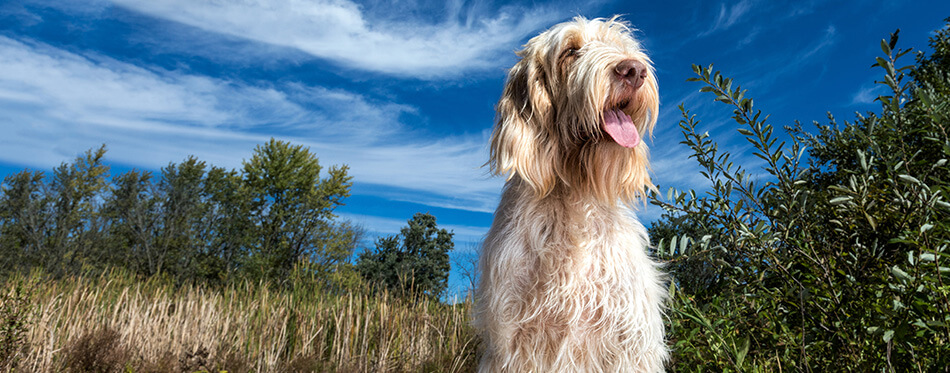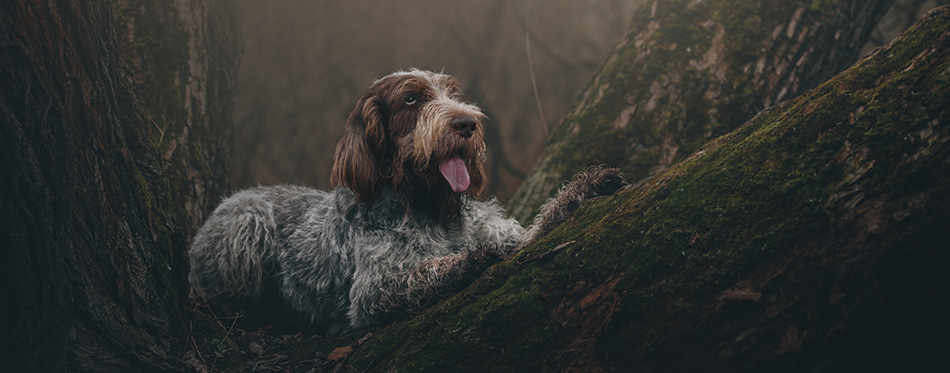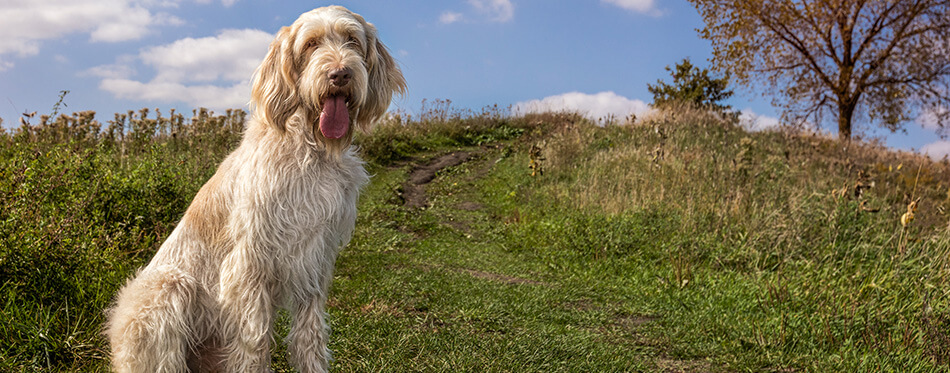A stunning, energetic, social, gentle, devoted, and hard-working breed. The Spinoni Italiani are known for their strong worth ethic, and their ability to adapt to any environment. If you’re looking to get a Spinone Italiano dog (otherwise known as Italian Spinone in English), then this guide should give you all of the facts, advice, and tidbits you should need to begin your Spinoni journey with this beautiful breed.
History of the Spinone Italiano
How Old is the Italian Spinone?
The Spinoni Italiani dog breed is an exceptionally old breed of hunting dog, thought to predate hunting with the use of guns (as they are well known for) by as far as a millennium. As a result of their ancient roots, it is virtually impossible to denote the precise origin of the breed, due to a lack of records denoting such things as dog breeding at the time. The information currently provided regarding the original parentage of the Spinone Italiano is based very much on what little information is already known of their history, and studies of their behavior, physicality, and capabilities, that may help experts to trace their lineage. Part of the debate regarding the breed is as to when the “modern” Spinone Italiano came to fruition, and there are conflicting theories that they were developed as early as 500BC, or that they became their best-known form by the early Renaissance period.
There is actually a piece of writing from 1683 by a French author by the name of Silcourt called “La Parfait Chasseur” (which translated to “The Perfect Hunter”), in which he appears to reference the modern Spinone Italiano by describing a griffon breed that was native to the Piedmont region.

Where do They Come From?
The Spinoni are widely believed to have originated from Continental Europe. The “Spinone” part of their name is in reference to undergrowth called Pino that can be found in the Piedmont regions of Italy, where they are believed to have been bred originally. This undergrowth is known to be very thorny, and it inspired the name due to the Spinone Italiano’s ability to work in such dense and dangerous areas without suffering severe injuries to their face, this is all thanks to their wiry coat! The steep and hilly terrain that Alpine Italy is knows so well for, proved to be both a lucrative and difficult hunting ground, and so the breeding of the Spinone Italiano dog breed made it possible to huntsmen to utilize the area for its full hunting potential.
What was the Spinone Italiano Dog Used For?
They are a breed that possesses a remarkably strong nose, great intelligence, versatility, relentlessness, and are able to retrieve just as well in the water as they can on land. Their endless stamina and determination made them into fantastic hunting dogs and their eagerness to keep on working with their boundless energy, strong prey drive, and natural hunting ability made them a perfect hunter’s companion.
The Italiano Spinone Dog in World War II
During World War II the breed was found to be perfect for tracking German troops, and so were used by Italian Partisans in an attempt to combat the German occupying forces. Thanks to their extremely powerful noses, they were able to sniff out the boot polish used by the Germans, which differed from the Italian boot polish, this guaranteed that they would never become confused between Italian and German troops. The robust nature of the Italian Spinoni dogs made them immensely valuable in the partisans’ efforts to combat the German forces, owing to their ability to work through extremely difficult terrain, regardless of the density, weather condition, or complexity, with a constant energy level.
Near Extinction
Their usefulness as a standard gun dog in England however had begun to dwindle as a result of people being unable to hunt, and so coupled with the detrimental loss they incurred during their time serving the Italian Partisans in World War II, the Spinoni Italiani became almost extinct. They were either being shot down whilst in the service of the partisan or starving to death once they had succeeded their usefulness and were no longer looked after. Though when the breed was in real danger of disappearing, a man by the name of Dr. Ceresolo took it upon himself to track down any Spinone Italiano that had survived and made every attempt to keep the breed going, and these efforts were not in vain, as he inspired others to do the same, and succeeded in saving the ancient breed from disappearing forever.
Their Journey to the United States
It wasn’t until later towards the end of the 20th century that the Spinone Italiano made it across to the United States following the demand for rare and interesting breeds. It was then that they became much loved by the American canine community, and were finally granted recognition by the United Kennel Club in 1995, shortly followed by The American Kennel Club in 2000.
Who are the Parents?
The ancestry of the Spinone Italiano is thought by the American Kennel Club to be a cross between a few breeds, originating with an Italian pointer such as the Italian Setter, alongside a couple of other breeds estimated to most likely be the White Mastiff and French Griffons.
Their Progression into The Spinone we know today
The actual origins of the Italiano Spinone are strongly debated amongst dog experts to this day. Spinoni are often placed within the Griffon family, which would put them in with the gundogs and scenthounds that are wire-haired and native to Continental Europe, as previously explained. But alongside the more widely accepted premise of their beginnings, there are still a few conflicting theories in regards to this. For example, some dog experts believe them to be more closely related to a couple of other breeds that originated from the British Isles, such as the Scottish Deerhound, or Irish Wolfhouse.
The mix of breeds, that were used in the eventual creation of the modern Spinone Italiano, are what gave the final dog breed its wide range of fur colors.
Quick Facts
- The males grow to be around 23-27 inches
- The females grow to be around 22-25 inches
- males weigh between 70 – 81 pounds
- females weigh between 64 – 75 pounds.
- Life expectancy: 10-12 years, though some have been known to live past 12 years.
- Known for its superior nose and ultra-soft mouth
- Also known as the Italian Coarsehaired Pointer
- They come in a wide range of colors
- They are a hunting breed or otherwise known as a pointer breed
- The Spinone Club of America was founded in 1987
- The Spinone Club of American is the official AKC parent club for the breed
- They are officially part of the Sporting Breeds group
- The term “pointer” comes from the tendency to point at what they are hunting
- They can be susceptible to developing several health problems such as entropion, cerebellar ataxia, hip dysplasia, and hyperthyroidism

Things You Should Know
So now for the information that you’ll want to know if you’re wanting Italiano Spinone puppies for yourself.
Exercise
Spinoni may have constant energy, but this doesn’t necessarily mean that they need to go on a 20-mile hike every day. They are in fact what is considered to be a “low octane” dog, meaning they are quite happy doing a lot less than you would think of a sporting breed. A Spinone Italiano loves to jump around and dig (what dog doesn’t?), and so they would get enough exercise in a nicely sized secured back garden, with some games to play, so long as you’re sure to give them some kind of walk every day too.
When it comes to outside play, training, and exercise (like dog sports), always engage yourself with them, they are social a dog that enjoys getting the chance to play with their owner and family. They are not meant to be left alone in a kennel all day, so be sure to keep them with you inside if you are not out walking or playing.
Field trials are also an excellent way to see what your Spinone is capable of, and training for it is also a great way of really working their boundless energy.
Nutrition
Though Spinone Italiano may be fussy (can’t we all?), they are actually a relatively simple breed to feed. Where some breeds may be best off on raw feed, dry dog food, wet dog food, or any other options, Spinone Italiano are quite happy with anything.
Always be sure to check that the food you are providing them with is of high quality, and appropriate for their age, then start with watch how they respond to it. Like any dog, there is always the possibility that they may react to their food, and seeing as most pure breeds have a more delicate constitution when it comes to food, your Spinone Italiano may seem to be struggling. If they do find a particular food difficult, simply switch it up until you find what works best.
Grooming
A Spinone Italiano has a dense wiry coat that feels coarse to the touch, and their coat length sits between 1.5-2.5 inches all over their body. However, it becomes shorts around their head and ears, as well as across the front of their legs and feet, they also have a lovely mustache and tufty little beard, with long eyebrows. A Spinone Italiano coat can come in a wide variety of colors; brown roan, orange roan, solid white, white and orange markings, white with brown markings, or even white with speckles of orange.
You must take care to brush them regularly, as they shed moderately and the longer fur can matt. Pay close attention to the fur around the face and feet, which can easily pick up food or outside debris. Their nails should also be cut once a week, along with cleaning their ears.
Check out some dog grooming guides, such as dog nail clippers, dog clippers, dog shedding brush, and dog ear cleaner.
Health
As was mentioned in the quick facts, a Spinone Italiano dog can develop several health conditions such as:
- Cerebellar ataxia: A disorder that is untreatable and can cause problems with voluntary movements, and symptoms include uncoordinated leg movements, a wide and unbalanced gait, and slow eye movement. If you start to notice any of these symptoms please consult your veterinarian who may be able to advise ways to help your dog to deal with the disorder.
- Hip dysplasia: Often hereditary and often affecting larger breeds, it causes pain, stiffness, an awkward gait that can look as though they are hopping, lameness, difficulty or reluctance to move, and decreased range of motion. This is a treatable condition but incurable.
- Hyperthyroidism: This causes a dog to lose weight at an accelerated rate resulting in them having a heightened appetite and enlarged thyroid glands. Should you notice weight loss in your Spinone Italiano, approach your vet immediately for advice on dietary adjustments.
- Entropion: An ocular condition that causes the eyelids to roll inward, which subsequently causes the fur to rub at the eyes and in severe cases can damage the cornea and lead to infection or blindness. This can be treated with drops or in more severe cases can be corrected surgically.
It is highly recommended that you be sure to check the health certificates of the parents before deciding on a puppy and that once you have them they have the following tests done:
- Hip evaluations
- Elbow evaluations
- Ophthalmologist evaluation
Hunting With Spinoni
When it comes to hunting with Spinoni, you must understand that they do not hunt at your command, wherever you want them to go. They are instinctual hunters with a high prey drive that will take them wherever they want to go and is likely to gear them towards smaller animals, and will work to put food on the table for you. a hunter must allow themselves to be taught by their Spinoni to trust them, and trust their natural ability.
They would benefit from basic training in terms of recall, responding, and fetching, however, the hunt itself is something they can do completely naturally.
Temperament
- How a Hunting Dog Breed Can be Expected to Behave
As a hunting dog, your Spinoni will be energetic, playful, eager, and loyal. Their natural tendency towards trusting their owner or huntsman will make them an extremely loving breed. Though the Italian Spinone can also tend towards being a bit of a pest with smaller animals such as cats, as their prey drive will draw them towards them.
- Would They Be a Good Family Companion Dog?
Quite the opposite to what some people may think of having pointing breeds in the home, the Spinone’s affection level is extremely high. They adore their family and need to be in the family home with everyone else when they are not working, exercising, or training. It is very much a family dog and is enjoyed in America equally as a family dog and a hunting dog. As an adult dog, they will be extremely gentle and patient, once they have worked past their boisterous puppy day, and their sweet nature would make them a fabulous friend to the children.
- Would They Make a Good Guard Dog?
The Spinoni are not the type of breed to be used as guard dogs. Though they are extremely adept hunters, they are very docile, social, energetic and intelligent, and would benefit much better from time with their family, training exercises such as obstacle training, and a good run around.
Training
As an extremely energetic, and enthusiastic breed, they require constant repetition when it comes to training. Even an adult dog can struggle to keep their kind on the task, as they are extremely intelligent and quick to learn that something else could be a lot more fun!
Don’t forget that they are sweet, gentle souls and will therefore respond extremely well to plenty of praise, positive reinforcement, and praise throughout the training process in order to keep their focus on the matter at hand.

General Knowledge
What makes them a Sporting Dog?
Their extremely alert and active nature combined with their soft and friendly personalities make these lovely well-rounded pets and ideal sporting dogs.
A sporting dog will be powerful, boundlessly energetic, and enjoy field activities such as hunting. The Spinone falls within the pointer category of the sporting dog class, which also included retrievers, spaniels, and settlers. Also, another aspect of sporting dogs, which befits a Spinone perfectly is their extremely well insulates and water repellent cats, which give them a natural resilience to the elements.
What Defines the Italian Spinone Breed?
An Italian Spinone, as you may have gathered by this point, can be known by several names, such as Spinone Italiano (or the plural of Spinoni Italiani), Wirehaired Pointer, and Italian Griffon, and has many defining features that meet the breed standard such as:
- Coat color: It is not considered acceptable for a Spinoni to have tri-colored coats, nor for there to be any black anywhere in their fur.
- Shape: Strong, muscular, laid back shoulders.
- Tails: They were once docked to half their length as was customary, however, when undocked their tails are thick and short haired.
- Movement: they have a free and relaxed gait.
- Size: Ranging from 23-25 inches
A simply stunning breed in capability, intelligence, history, look, and temperament. Though they may be hard to get, a Spinone Italiano would most certainly be worth the wait.
Source:
- Spinone Italiano – AKC

